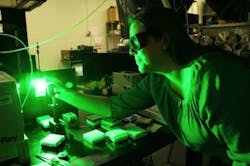Two-dimensional ultrafast spectroscopy shows dynamics of nitrogen-vacancy centers in diamond
Tucson, AZ--Using ultrafast laser spectroscopy, a team of researchers led by University of Arizona (UA) assistant professor Vanessa Huxter has have made the first detailed observation of how energy travels through diamonds containing nitrogen-vacancy (NV) centers—defects in which two adjacent carbon atoms in the diamond's crystal structure are replaced by a single nitrogen atom and an empty gap.1 NV centers are promising candidates for a variety of technological advances such as quantum computing.
An NV center's properties depend on the vibrational state of the center, which determines the details of decoherence, relaxation, and spin-orbit coupling (which pertain, for example, to the length of time an NV center can hold its quantum state in a quantum computer).
Huxter notes that because NV defects can be manipulated with lasers, they could be used for computing, data storage, sensing, and advanced imaging techniques capable of revealing the structure of molecules. "In order to use this system for these applications, we have to understand its fundamental properties," says Huxter, whose team is the first to study the ultrafast dynamics in these crystals in real time. "To use these systems for quantum computing, you want to have to some idea of what we call vibrational modes, because they determine the local environment and may possibly be used for information processing."
2D correlation map
Huxter and her team used two-dimensional electronic spectroscopy, which creates 2D correlation "maps" that allow the researchers to watch the system as it relaxes to the ground state. An ultrafast-laser pulse is used to move electrons in NV centers into an excited state. Over time, the electrons fall back into their ground state, in a process called relaxation, while dissipating the energy into their surroundings. The relaxation occurs on a time scale of a few nanoseconds. Just how that energy moves through the crystal and how it influences the vibrations around the NV centers is crucial to figuring out how to take advantage of its properties.
"This is the first time we have been able to directly observe the vibrational spectrum of the system in real time," notes Huxter.
"The question we ask is, what happens when you start replacing the atoms in the crystal?" says Huxter. "Will you get a change in the elastic properties? Each nitrogen-vacancy center is like a softer region you can poke at. They absorb the laser energy where there was previously no absorption and we see all these extra vibrational modes we don't see in the rest of the crystal. In our scenario, the diamond is like a clear window. We look straight through it and only see the defects. We tailor our laser pulse to the absorption of the defects."
Huxter recently joined the UA's Department of Chemistry and Biochemistry and led the research during a postdoctoral fellowship funded by the Natural Sciences and Engineering Research Council of Canada. Huxter did the research with co-authors Graham Fleming and Dmitry Budker at the U.S. Department of Energy's Lawrence Berkeley National Laboratory and the University of California, Berkeley.
REFERENCE:
1. V. M. Huxter et al., Nature Physics (2013) doi:10.1038/nphys2753.

John Wallace | Senior Technical Editor (1998-2022)
John Wallace was with Laser Focus World for nearly 25 years, retiring in late June 2022. He obtained a bachelor's degree in mechanical engineering and physics at Rutgers University and a master's in optical engineering at the University of Rochester. Before becoming an editor, John worked as an engineer at RCA, Exxon, Eastman Kodak, and GCA Corporation.
